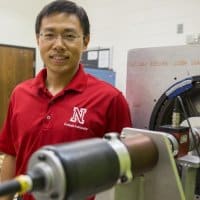An engineering student from the University of Nebraska-Lincoln has invented a prototype system that improves the efficiency of wind turbines by capturing and storing what would otherwise be wasted wind energy for later use.
Like solar technology, wind power systems rely on intermittent source of energy to produce electricity. When the wind becomes a light breeze or dies entirely, the wind turbine stops turning. Even when the wind is blowing, there are major inefficiencies.
Today’s wind turbines are only capable of capturing around 60 per cent of the kinetic energy passing through them and once a wind speed threshold is reached; conventional turbines automatically angle their blades to avoid mechanical damage and maintain optimal power output.
This “mechanical spillage” of potential energy means wind turbines fail to realise their full potential, according to Jie Cheng, PhD candidate from UNL.
His system captures and stores spillage by replacing the traditional speed-up gearbox with a differential planetary gearbox and adding a rotary vane machine and air compression chamber. The system engages until the wind speed drops back to a point where the turbine can return to normal operations. The tank then releases its stored energy during times of deficit.

“The biggest problem for wind energy is that it’s not a reliable energy resource,” Cheng said. “Even if there’s not enough wind to generate electricity, the community still needs it. If we can (scale up) this system, it could improve reliability by producing electricity even when there’s no wind.”
In a recent study using historical wind data from rural Nebraska, Cheng compared the performance of a conventional wind turbine against his prototype for a week and found a 250-kilowatt system would generate an additional 3,830 kilowatt-hours of electricity per week – about 16,400 extra kilowatt/hours a month – more than 18 times the monthly consumption of an average American household.
The study also found Cheng’s system would marginally cut total energy costs while significantly reducing fluctuations in power generation. Cheng said Nebraska’s strong wind farm economy would provide the ideal test bed for perfecting his prototype while working with university and industry partners on bringing the system to market.
“We have a lot of wind energy here, and we live among grasslands, so there’s little environmental (interference),” he said. “I see a lot of potential for this, especially in Nebraska.”
Cheng’ work has been published in The Journal of Power and Energy Engineering












































